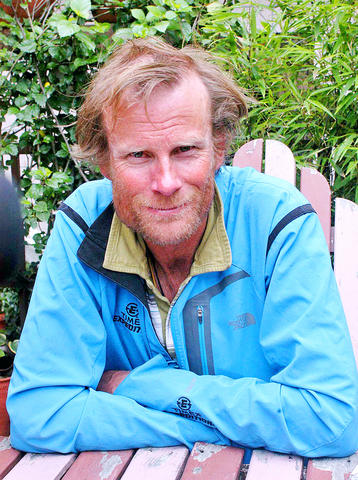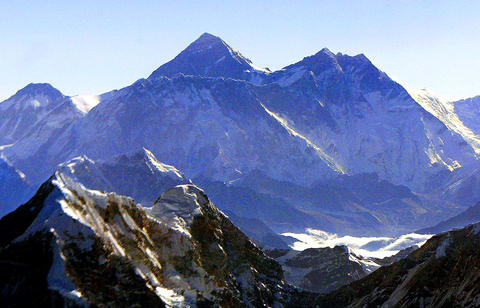Why climb Everest?
The acclaimed climber George Mallory nailed it with his famous line, "Because it's there."
Meant to fend off reporters, it became the Mona Lisa smile of answers. It said nothing, yet it seemed to capture Everest's mystique, as well as the mystery and danger that were Mallory's lifeblood.

PHOTO: AP
After recently returning from his second ascent of the world's tallest peak, Conrad Anker has a different answer: "Because Everest pays," said Anker, 44, a mountaineer who is also planning to put three boys through college. "I can make money on Everest. I'll be brutally honest."
Growing up in Big Oak Flat, California, Anker said, he was as fascinated by the stories of J.R.R. Tolkien's Hobbits as with the exploits of adventurers like Mallory and Ernest Shackleton. He carried an explorer's zeal to the big walls of Yosemite Valley, and later Alaska, Patagonia, Antarctica, Baffin Island and the Himalayas. He became known in mountaineering circles for pioneering difficult new routes in the most remote places.
"That's what great stories are always founded upon," he said. "They would go out into the mythic unknown, endure hardship and turmoil, and then come back."

PHOTO: AFP
Or not. Mallory and his partner Andrew Irvine disappeared in the clouds on Everest's North Face in 1924, sparking one of the greatest mountaineering debates of the 20th century: Had the two men been the first to summit the highest peak on earth?
The debate raged anew when Anker discovered Mallory's body high on Everest during a search expedition in the spring of 1999. Once known only to mountaineers and their fans, Anker's name was suddenly appearing in news accounts worldwide. His subsequent book, The Lost Explorer, written with David Roberts, offered Anker's take on the debate. "I believe there is no possible way Mallory and Irvine could have reached the summit," he wrote.
Anker's career was at its apex. That is when calamity struck. In the fall of 1999, Anker narrowly survived an avalanche on Tibet's 8,000m Shishapangma. His closest friend and climbing partner, Alex Lowe, considered one of the best climbers in the world, was not so fortunate.
Like most climbers of Anker's standing, Anker was no stranger to death. But Lowe's death on Shishapangma proved transformational. A sense of shared loss drew Anker closer to Lowe's widow, Jennifer, and their three sons. Anker moved to Bozeman, and by April 2001, he and Jennifer were married, and he became a father to the three boys.
"I think that his biggest concern was to fill the hole that Alex left in our personal life - me and the boys," Jennifer Lowe-Anker said. "And he's done a wonderful job with that." Despite spending more time at home and concentrating on safer routes, Anker remains a professional mountaineer. His June trip to Everest was at the behest of Altitude Films, which was producing a documentary on Mallory. For the occasion, Anker and his partner Leo Houlding dressed in period mountaineering outfits - leather hobnailed boots and seven layers of fabrics, including "a double-breasted button-down jacket with a wool sweater and tie; and a fedora."
Anker said that along with being not terribly warm, the non-elasticized layers restricted movement. "There they were, 300m from the summit of Mount Everest, in basically fashion clothing," he said. The clothes were only for the movie shoot; the climbers abandoned the outfits for modern gear higher on the peak.
Anker refers to climbs as "revenue trips," and wearing costumes and playing a role is part of it. Fortunately, he likes his job.

In the March 9 edition of the Taipei Times a piece by Ninon Godefroy ran with the headine “The quiet, gentle rhythm of Taiwan.” It started with the line “Taiwan is a small, humble place. There is no Eiffel Tower, no pyramids — no singular attraction that draws the world’s attention.” I laughed out loud at that. This was out of no disrespect for the author or the piece, which made some interesting analogies and good points about how both Din Tai Fung’s and Taiwan Semiconductor Manufacturing Co’s (TSMC, 台積電) meticulous attention to detail and quality are not quite up to

Chinese Nationalist Party (KMT) Chairman Eric Chu (朱立倫) hatched a bold plan to charge forward and seize the initiative when he held a protest in front of the Taipei City Prosecutors’ Office. Though risky, because illegal, its success would help tackle at least six problems facing both himself and the KMT. What he did not see coming was Taipei Mayor Chiang Wan-an (將萬安) tripping him up out of the gate. In spite of Chu being the most consequential and successful KMT chairman since the early 2010s — arguably saving the party from financial ruin and restoring its electoral viability —

It is one of the more remarkable facts of Taiwan history that it was never occupied or claimed by any of the numerous kingdoms of southern China — Han or otherwise — that lay just across the water from it. None of their brilliant ministers ever discovered that Taiwan was a “core interest” of the state whose annexation was “inevitable.” As Paul Kua notes in an excellent monograph laying out how the Portuguese gave Taiwan the name “Formosa,” the first Europeans to express an interest in occupying Taiwan were the Spanish. Tonio Andrade in his seminal work, How Taiwan Became Chinese,

Toward the outside edge of Taichung City, in Wufeng District (霧峰去), sits a sprawling collection of single-story buildings with tiled roofs belonging to the Wufeng Lin (霧峰林家) family, who rose to prominence through success in military, commercial, and artistic endeavors in the 19th century. Most of these buildings have brick walls and tiled roofs in the traditional reddish-brown color, but in the middle is one incongruous property with bright white walls and a black tiled roof: Yipu Garden (頤圃). Purists may scoff at the Japanese-style exterior and its radical departure from the Fujianese architectural style of the surrounding buildings. However, the property